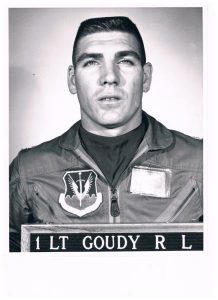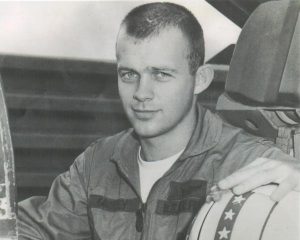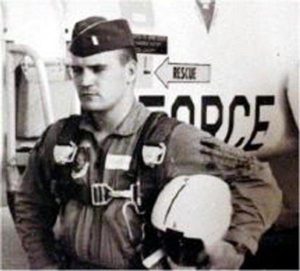9 August 1965 – Capt (then 1Lt) Richard Lee Goudy of Sharon Springs, KS, graduated #12 from Pilot training, Class 62G, at Moody AFB. He chose the last F-100 assignment.  In August of 1965, he was serving with the 429TFS/474TFW. On a strafing mission over SVN his aircraft was hit by gunfire. The official report reads ‘Goudy was reported missing and ultimately declared dead on August 9, 1965. Recorded circumstances attributed to: “Hostile Died While Missing, Air Loss Crash – Land, Fixed Wing – Pilot”. Incident location: South Vietnam, Pleiku province.'(1)
In August of 1965, he was serving with the 429TFS/474TFW. On a strafing mission over SVN his aircraft was hit by gunfire. The official report reads ‘Goudy was reported missing and ultimately declared dead on August 9, 1965. Recorded circumstances attributed to: “Hostile Died While Missing, Air Loss Crash – Land, Fixed Wing – Pilot”. Incident location: South Vietnam, Pleiku province.'(1)
Richard is buried at Leavenworth National Cemetery and is listed on the Vietnam Veteran’s Memorial in Washington DC. Name inscribed at VVM Wall, Panel 02e, Line 49.
9 August 1969 – Laurent Lee Gourley graduated from the U. S. Air Force Academy in 1966, and Jefferson “Scott” Dotson graduated from VA Military Academy in 1966. On August 9, 1969, Capt Laurent Lee Gourley and 1Lt Jefferson Scott Dotson left Tuy Hoa AB for a mission over the Ho Chi Minh trail.
 In the early morning of August 9, 1969, 1Lt. Jefferson S. Dotson, rear seat co-pilot, and Capt. Lee Gourley, pilot, departed Tuy Hoa Airbase located on the coast of central South Vietnam on a “Misty” Forward Air Control (FAC) mission over the Ho Chi Minh Trail in central Laos.
In the early morning of August 9, 1969, 1Lt. Jefferson S. Dotson, rear seat co-pilot, and Capt. Lee Gourley, pilot, departed Tuy Hoa Airbase located on the coast of central South Vietnam on a “Misty” Forward Air Control (FAC) mission over the Ho Chi Minh Trail in central Laos.
Lee Gourley had written home early that same day saying that all missions for that day had been scrubbed due to bad weather. He did not expect to have to fly that day – and he had time to write his family. Gourley had been working with Misty for some time as a volunteer. Misty FAC volunteers were chosen from among the best and most experienced pilots. He had delayed a trip to Hawaii for R & R until the Misty duties were complete in another week, knowing his time in the Vietnam arena would be short following his return. The FAC mission had come up unexpectedly.
The aircraft Dotson and Gourley flew, the F100 Super Sabre, had been specially modified a few years before to include a second crewman. The F model, introduced in 1965, had the latest technology in radar signal detectors. The initial shipment of F100F’s were called “Wild Weasel I” and were an important element in several combat operations.
Gourley and Dotson were not on a Wild Weasel mission, however, and on the FAC mission this day, no bombs were loaded. They were to fly low and fast over their objective area and presumably analyze targets for future air strikes, or assess the potential need for further strikes. FAC reconnaissance missions in the traditional sense were often flown by light observation aircraft rather than fighter/bombers, but the necessary element for this mission was low altitude and high speed, as well as the ability to cover a large territory.
Although there was normally no scheduled air backup or escort on a FAC mission, and Gourley and Jefferson had none, other aircraft which happened to be in the area provide information as to what happened to Dotson and Gourley as they flew near Sepone in Savannakhet Province, Laos.
One passing aircraft intercepted a radio transmission from the F100F, “We’ve been hit, we’re going to try to get out.” Observers from the passing aircraft then saw the F100 go up in flames, and observed one fully deployed parachute. (NOTE: The standard ejection called for the rear-seater, Gourley, to make the first ejection, then the pilot, and a fully deployed chute indicated the successful ejection of a crew member.)
Dotson and Gourley were classified Missing in Action. Their families understood that they might have been captured, and like the families of others who were missing, wrote regular letters.
Lee Gourley’s sister, Elzene, became active in the POW/MIA families’ effort to “watchdog” U.S. Government actions regarding American Prisoners of War held in Indochina. In early 1973, Secretary of State Henry Kissinger came to the POW/MIA families and announced that peace agreements were ready to be signed and their men would soon be home, or accounted for, if they were dead. Elzene Gourley specifically asked Kissinger about the prisoners in other countries besides Vietnam – Laos, Cambodia and China – and if his good news included the
men missing there. Kissinger replied, “What do you think took us so long?”
When 591 American prisoners were released from communist prison camps in Southeast Asia in the spring of 1973, it became apparent that Kissinger had lied to the POW/MIA families. Not a single man who had been held in Laos had been released. Although the Pathet Lao had spoken publicly of American prisoners they held, and many were known to have survived their loss incidents, the U.S. had not negotiated the freedom of the American POWs held in Laos.
In 1974, the Gourley’s sent a letter to Lee in care of the Prime Minister of Laos, who responded that the letter would be conveyed later to their son. The U.S. State Department said the Prime Minister might not know English and probably an error was made in translation.
In 1976, the Gourley’s wrote to Lee in care of Prince Souvanna Phouma in Vientiane, Laos. He wrote back that he would give their letter to the “central committee” to be sent to the “one for whom (it was) intended.” The U.S. State Department ordered the Gourley’s to quit writing Lee in care of the Lao.
Following the war, refugees fled Southeast Asia and brought with them stories of Americans still held prisoner and other information relating to Americans missing in their homelands. By 1989, the number of such reports approached 10,000, and most authorities reluctantly had concluded that many Americans had been still be alive and held captive.
The remains found at the crash site in Vietnam in the Spring of 2001 were identified as Laurent Lee Gourley and Jefferson Scott Dotson. They were returned to their families in 2002. (1)
Source: (1) POW Network
